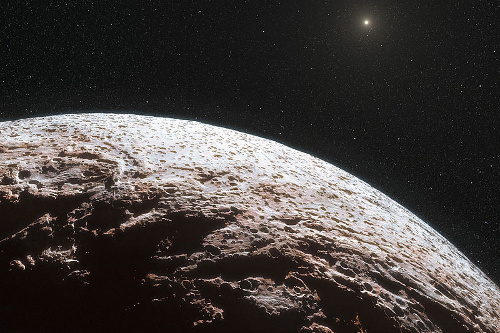Astronomers have reported on the results of using seven telescopes to take advantage of their first chance to study one of five dwarf planets in our solar system. They were able to get a rare insight into Makemake thanks to it passing in front of a distant star.
Makemake was originally considered as one of four dwarf planets alongside Cereas, Eris and Haumea. In 2006 Pluto was “downgraded” to join the category after the International Astronomical Union agreed new definitions. Now a dwarf planet is something big enough to be controlled by gravitational forces, but not big enough to have “cleared the neighborhood of its orbit.”
The Andalucian Institute of Physics studied Makemake: although based in Spain, the institute used telescopes across Chile and Brazil. With Makemake’s comparative size and difference to Earth likened to “the size of a quarter sitting 30 miles away”, it took several goes to correctly predict when it would pass in front of a star.
That finally happened for just a minute on April 23 last year, which allowed the astronomers to deduce details about Makemake. Usually when we see an object pass in front of a bright background object (such as a solar eclipse), the background object appears to fade out and then fade in again.
With Makemake the background object (the star Nomad 1181-0235723) switched from visible to invisible and then back again abruptly, an effect the astronomers likened to the star winking. From this they’ve concluded that, contrary to expectations, Makemake has no significant atmosphere.
It certainly doesn’t have atmosphere that surrounds the entire planet but may have patches of atmosphere above certain parts of the surface. One explanation for that, based on previous observation, is that the brightness of differing terrain on the planet affects the reflection of light so significantly that in turn some regions of the surface are warm enough to heat methane ice and turn it into the gas that makes up such patches.
The astronomers noted that different telescopes noted different periods of time for the background light disappearing. That could be because they were at fractionally different angles and thus some caught patches of atmosphere while others didn’t. However, the astronomers can’t confidently rule out that this variation was simply instrument error.
The testing also allowed the astronomers to calculate that Makemake is not quite a perfect sphere: it’s around 1,430 kilometers across in one direction but 1,500 in the other. They also estimated that it has a density of 1.7 grams per cubic centimeter, similar to that of Pluto.
(Image is artist impression. Credit: ESO/L. Calçada/Nick Risinger (skysurvey.org))

